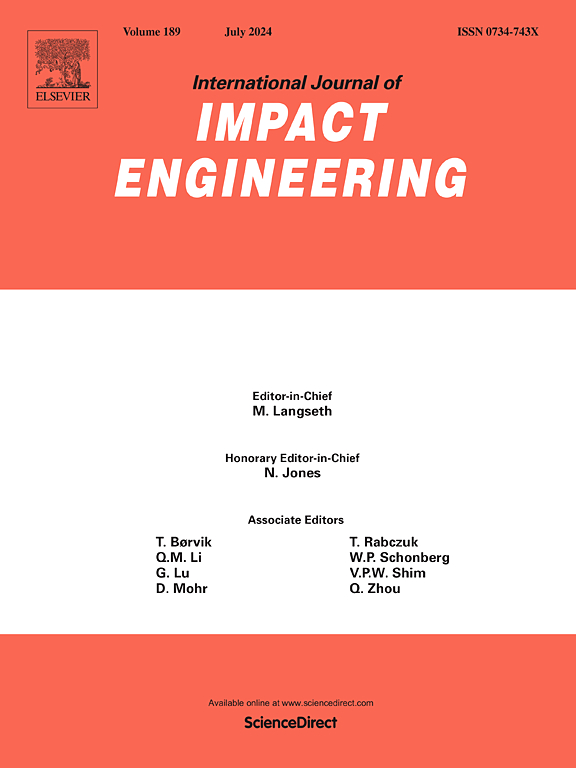Numerical investigations on the dynamic response of steel plates subjected to near-field explosions using a two-stage uncoupled approach
IF 5.1
2区 工程技术
Q1 ENGINEERING, MECHANICAL
International Journal of Impact Engineering
Pub Date : 2025-05-27
DOI:10.1016/j.ijimpeng.2025.105404
引用次数: 0
Abstract
The dynamic response of structures subjected to blast loading has long been a concern in the blast engineering community. Steel plates are widely used in various structures (e.g. buildings, bridges, ships and vehicles). Recently, a two-stage uncoupled numerical approach (2Stage-DI) was proposed by Rigby et al. [1] to predict the plate response for near-field scenarios. This study aims to evaluate the two-stage uncoupled approach for the prediction of the dynamic response of blast-loaded plates with respect to the applicable scaled distance range. In addition, it provides insights into the effects of the plate shape, dimension and thickness on the applicable scaled distance range of the 2Stage-DI model, offering practical guidelines for the blast-resistant design. Three different types of numerical models are developed, i.e. the fluid-structure interaction (FSI) model, the two-stage uncoupled models with distributed impulses (2Stage-DI) and uniform impulses (2Stage-UI). Unlike the 2Stage-DI model, the 2Stage-UI model adopts the energy-equivalent impulse for the conversion of the nodal velocities, which are uniformly distributed over the plate. The FSI and 2Stage-DI models are validated against the test data of three experiments. After that, the validated FSI models are used as the reference to evaluate the applicable scaled distance range of the 2Stage-DI models for steel plates of different shapes (square and circular), dimensions and thicknesses. Several important conclusions are drawn from this study. Firstly, the 2Stage-DI model is significantly less time-consuming than the FSI model. Secondly, the circular plate has a broader applicable scaled distance range of the 2Stage-DI models than the square plate with the same surface area. Thirdly, the applicable scaled distance range of the 2Stage-DI model expands when the plate dimension (length or diameter) increases. Fourthly, the applicable scaled distance range of the 2Stage-DI model is first increased and then decreased with the thickness. Lastly, the 2Stage-UI models, which are based on the equivalence of the kinetic energy of the steel plates, are also feasible to predict the plate response for near-field scenarios.
近场爆炸作用下钢板动力响应的两段不耦合数值研究
爆炸荷载作用下结构的动力响应一直是爆炸工程界关注的问题。钢板广泛应用于各种结构(如建筑、桥梁、船舶和车辆)。最近,Rigby等人提出了一种两阶段不耦合数值方法(2Stage-DI)来预测近场场景下的板响应。本研究的目的是评估两阶段不耦合方法在适用的尺度距离范围内预测爆炸加载板的动态响应。此外,研究了板的形状、尺寸和厚度对2Stage-DI模型的适用缩放距离范围的影响,为防爆设计提供了实用的指导。建立了三种不同类型的数值模型,即流固相互作用(FSI)模型、分布脉冲两级不耦合模型(2Stage-DI)和均匀脉冲模型(2Stage-UI)。与2Stage-DI模型不同,2Stage-UI模型采用能量等效脉冲进行节点速度的转换,节点速度在板上均匀分布。FSI和2Stage-DI模型通过三个实验的测试数据进行了验证。然后,以验证的FSI模型为参考,评估2Stage-DI模型对不同形状(方形和圆形)、尺寸和厚度的钢板的适用比例距离范围。从这项研究中得出了几个重要结论。首先,2Stage-DI模型比FSI模型明显节省时间。其次,在相同表面积的情况下,圆形板比方形板具有更宽的2Stage-DI模型适用比例距离范围。第三,随着板材尺寸(长度或直径)的增加,2Stage-DI模型的适用比例距离范围扩大。第四,2Stage-DI模型的适用尺度距离范围随厚度先增大后减小。最后,基于钢板动能等效的2Stage-UI模型也可用于近场场景下的钢板响应预测。
本文章由计算机程序翻译,如有差异,请以英文原文为准。
求助全文
约1分钟内获得全文
求助全文
来源期刊

International Journal of Impact Engineering
工程技术-工程:机械
CiteScore
8.70
自引率
13.70%
发文量
241
审稿时长
52 days
期刊介绍:
The International Journal of Impact Engineering, established in 1983 publishes original research findings related to the response of structures, components and materials subjected to impact, blast and high-rate loading. Areas relevant to the journal encompass the following general topics and those associated with them:
-Behaviour and failure of structures and materials under impact and blast loading
-Systems for protection and absorption of impact and blast loading
-Terminal ballistics
-Dynamic behaviour and failure of materials including plasticity and fracture
-Stress waves
-Structural crashworthiness
-High-rate mechanical and forming processes
-Impact, blast and high-rate loading/measurement techniques and their applications
 求助内容:
求助内容: 应助结果提醒方式:
应助结果提醒方式:


